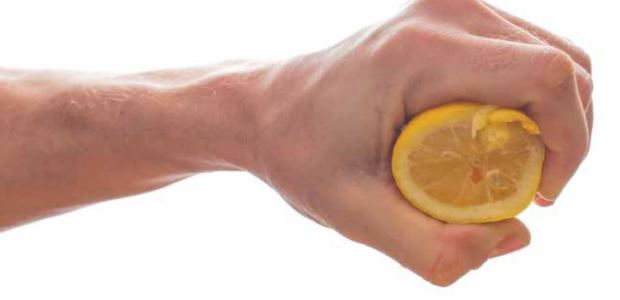
Your Best in Class Safety Program
The C-Team is constantly looking to squeeze more juice from the company lemon. Mitigating your exposure to costly accidents is the proverbial "low hanging fruit."
I have worked the past 30 years in the property-casualty insurance industry; the first 15 in Claims (cleaning up after accidents) and the last 15 years in Loss Prevention (helping customers prevent and avoid accidents). I have seen it all: The best loss prevention programs. And the absolute worst, as well. In my experience, Best in Class safety programs tend to have the following elements in common:
- Every manager in the organization has some "skin in the game" when it comes to the safety results of those they supervise. Absent this, the program never approaches Best in Class. For example, "This year, 25 percent of your performance appraisal will be based on how your team performs safety-wise." Boom! Now, there is "walk" in the safety "talk." Safety management, after all, is really nothing more than just good management.
- Acknowledge and reward those who exceed your safety expectations. If you only reward production, your front-line managers will talk safety but there will be no walk in the safety talk.
- While every manager has skin in the game, overall authority for the program's success should reside in one manager and not be spread among several. In my experience, when "everyone" is responsible for safety, no one is. When an organization's loss experience deteriorates, the CEO needs to be able to look to one manager for an explanation and answers, not six.
- Every manager should know what the organization’s current workers' compensation Experience Modification Rating (Mod) is. Literally, your insurance rate is modified by your company's loss experience compared to its industry peers. The Mod is not only a reflection of how a company manages its risk. Today, most of the country's largest general contractors will not even allow a subcontractor to bid on a job if their Mod is worse than industry average. Every year your company's Mod exceeds 1.0 means you are paying more than your average industry peer for the same amount of insurance. A weak safety program can prevent you from landing work and is always a profit margin killer.
- An accident is a red flag that something is not quite right, either with that worker or your process. Every accident—no matter how minor—must be promptly investigated for root cause. Even near misses should be investigated. If it almost happened, that means it can (and probably will) eventually happen. It is much better to fix it now than wait for an injury to occur.
- When investigating an accident for root cause, keep asking "But why?" "But why did you feel you needed to rush? But why were the parts not there when you needed them? But why were they ordered so late?" Follow the investigation wherever it leads you. And do not be surprised if it leads you back to the Human Resources Department.
- Being thorough/careful about whom you bring into your company as a new hire is the most potentially impactful loss control at a company's disposal. Many of my customers no longer call prior employers for a reference, claiming "they never tell you anything." I challenge that claim. At a minimum, you should be able to confirm dates of employment. It is a red flag when an applicant misrepresents on the application how long he/she worked for someone else. How an employer talks about a former employee is often more meaningful than the actual words spoken.
- No injured worker should be allowed to recuperate unsupervised at home, as that only encourages malingering. If the employee is able to walk and drive his/her car (i.e., has a work capacity), insist that he or she come to work. You can always find something meaningful for them to do, even if it is just for a couple hours. You pay them for the first two hours and the workers' comp carrier pays them for the rest of the shift. The key is to keep them coming to work every day. Again, no one gets paid to recuperate unsupervised at home.
- One manager should be in charge of your Return to Work (RTW) program. Put your program details in writing and review it with every new hire as part of their on-boarding.
- Retain ownership of any lost-time accident. This means your RTW coordinator stays in regular contact with the employee, medical provider, and claim adjuster on any lost-time claim.
- Identify a local medical provider willing to partner with you in keeping employees on the job.
- Make a "honey-do" list of light duty jobs that are available at your facility and share it with the medical provider. Invite the provider to visit your facility to see in person the physical demands of the production jobs and the "transitional duty" work that is available.
The C-Team is constantly looking to squeeze more juice from the company lemon. Mitigating your exposure to costly accidents is the proverbial “low hanging fruit.” For a relatively modest investment of time and capital, the company receives considerable pay back in the form of reduced insurance costs, improved productivity, and you spare yourself all the “uninsured,” non-valued added work that accompany accidents. These uninsured costs typically exceed the costs covered by insurance. (See http://www.osha.gov/dcsp/smallbusiness/safetypays/estimator.html.)
Hire well. Find creative ways to keep your good workers from leaving. Make sure every manager in your organization has some skin in the game when it comes to safety. Aggressively investigate all incidents for root cause. Actively manage every workers' compensation claim. Do that and your organization will be well on its way to a Best in Class safety program.
This article originally appeared in the July 2017 issue of Occupational Health & Safety.
About the Author
Thomas R. Knight is a Certified Industrial Hygienist (CIH) who has been providing risk management advice to commercial insurance customers for 30+ years.